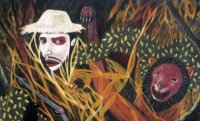Philippine Legends, Mythology and Folklore
Philippine legends, or alamat ng Pilipinas (legend of the Philippines), and mythology are derived from Philippine folk literature, which is the traditional oral literature of the Filipino people.
This refers to a wide range of material due to the ethnic mix of the Philippines. Each unique ethnic group has its own stories and myths to tell.
While the oral and thus changeable aspect of folk literature is an important defining characteristic, much of this oral tradition had been written into a print format.
To point out that folklore in a written form can still be considered folklore, it should be pointed out that all the examples of folk literature cited in this article are taken from print, rather than oral sources.
Philippine legends, mythology and folklore include a collection of tales and superstitions about magical creatures and entities. Some Filipinos, even though heavily westernized and Christianized, still believe in such entities.
The prevalence of belief in the figures of Philippine mythology is strong in the provinces.
Because the country has many islands and is inhabited by different ethnic groups, Philippine legends, mythology and superstitions are very diverse. However, certain similarities exist among these groups, such as the belief in Heaven, Hell and the human soul.
 Philippine Legends, Mythology, Folklore |
University of the Philippines professor, Damiana Eugenio, classified Philippine Folk Literature into three major groups: folk narratives, folk speech, and folk songs.
Folk narratives can either be in prose: the myth, the alamat ng Pilipinas (legend of the Philippines), and the kuwentong bayan (folktale), or in verse, as in the case of the folk epic.
Folk speech includes the bugtong (riddle) and the salawikain (proverbs).
Folk songs that can be sub-classified into those that tell a story (folk ballads) are a relative rarity in Philippine folk literature. These form the bulk of the Philippines' rich heritage of folk songs.
The stories of ancient Philippine legends and mythology include deities, creation stories, mythical creatures, and beliefs. Ancient Philippine mythology varies among the many indigenous tribes of the Philippines.
Some groups during the pre-Spanish conquest era believed in a single Supreme Being who created the world and everything in it, while others chose to worship a multitude of tree and forest deities (diwatas).
Filipinos also believed in mythological creatures. Below are some of the gods and goddesses of the various ancient Philippine tribes:
The Aswang (monster) is one the most famous of these Philippine mythological creatures. The aswang is a ghoul or vampire, an eater of the dead, and a werewolf.
Filipinos also believed in the Dila (The Tongue), a spirit that passes through the bamboo flooring of provincial houses, then licks certain humans to death.
Philippine legends and mythology also have fairies, dwarfs, Kapre (a tree-residing giant), Manananggal (a self-segmenter), witches, spirit-summoners, goblins (Nuno sa Punso), ghosts (Multo), fireballs (Santelmo), mermaids (Sirena), mermen (Siyokoy), demon-horses (Tikbalang), Hantu Demon and demon-infants (Tiyanak). These all contribute to the fascinating alamat ng Pilipinas (legend of the Philippines).


